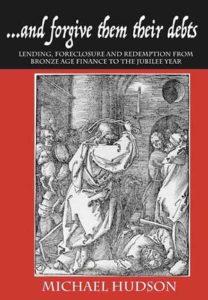… And Forgive Them Their Debts: Lending, Foreclosure, and Redemption from Bronze Age Finance to the Jubilee Year
Reviewed by Forrest Curo
March 1, 2019
 By Michael Hudson. ISLET-Verlag Dresden, 2018. 340 pages. $29.95/hardcover; $26.95/paperback.
By Michael Hudson. ISLET-Verlag Dresden, 2018. 340 pages. $29.95/hardcover; $26.95/paperback.
The authors of the Bible never guessed how puzzled we would be by things they didn’t think needed explanation. Why did certain people want to kill Jesus? Why would he accuse the Pharisees of “neglecting the weightier matters of the Torah: justice, mercy, and good faith” (to paraphrase Matthew 23:23)? It isn’t obvious to us, from 2,000 years away, that these “weightier matters” were laws about land, debt, interest, foreclosure, and slavery. Modern Americans don’t understand how or why the Torah could have demanded loans without interest or foreclosure, or land sales limited to a seven-year term. The idea of the Jubilee (years when debts were forgiven and land returned to debtors) seems marvelous, yet we’ve doubted it ever could have taken place.
From his experience as a modern economist, a historian of economic theory, and a scholar researching ancient economies from their Near-Eastern beginnings to the end of the Byzantine Empire, Michael Hudson says that clean slate proclamations had been widely practiced by previous civilizations. Far from being radical innovations, they stabilized a society by reversing its built-in tendency to downward mobility.
A Near-Eastern ruler wanted small farmers working and fighting for him, not losing their land and families to powerful creditors. When a new king came to power, or faced war, or simply found an occasion to celebrate, he would proclaim a clean slate, restoring farmland to previous owners and freeing everybody enslaved for debt. Commercial loans, houses within cities, and people captured in warfare were unaffected. It was the small farmers who unavoidably fell into debt for minor fees and operating expenses, and were forced to incur interest charges that staple crops—however essential—could never cover. These people, the bulk of the population, rejoiced at clean slate proclamations. Their creditors did not.
We find this kind of law fairly early in the Bible, before the stories of Saul and David. Then, under the monarchies of Judah and Israel, prophets often denounce the elites for coveting—and taking—their neighbors’ wives and property, but they say nothing about Moses making such things illegal. Under Jeremiah’s influence, we have the only example of a biblical king calling for the release of all Hebrew slaves, and this, as Hudson points out, comes as a military response to a threat from Babylon.
When the Babylonian army turns aside, the Judean elite immediately force their bondsmen and bondswomen back into slavery. That, according to Jeremiah, ensured that Jerusalem would fall to Babylon, that its leaders would soon be taken away into exile. Years later, when the exiles’ descendants returned to rule Jerusalem under the Persian Empire, they were still compiling their Scriptures into their final form, and they had learned from Babylonian tradition that periodic clean slate measures were needed to keep an agrarian state in good order. Hence, Hudson says: “Jewish religion and its biblical narrative reflected an economic conflict that culminated in taking the role of protecting debtors out of the hands of kings and placing it at the center of Mosaic law.”
Jesus has been depicted before as a defender of the Torah’s provisions for the protection of the poor, but Hudson’s background gave me a better sense of why he would approach (and naturally fall afoul of) the Temple priests in Jerusalem. No book can provide a complete explanation for Jesus’s life and teachings, but this one is an improvement over the unsatisfactory “harmless teacher” and “nonviolent insurrectionist” alternatives we’ve typically been offered.
This is not primarily a religious book, but it supplies some long-needed background on how and why Judaism and Christianity have taken the forms they have. It also provides a wealth of detail on the politics of debt relief from its Sumerian origins to its eventual suppression in the civilizations of Greece and Rome. The complexities of the debtor-creditor conflict from one time and nation to another are somewhat overwhelming but very well explained.
Hudson is not an apologist for what John Kenneth Galbraith used to call “the conventional wisdom”; like Galbraith, he is a clear writer focused on the politics and workings of actual contemporary economies. He writes:
Mainstream economists depict money and debt as only a veil, not affecting the distribution of income and wealth except to finance growth. Even in the wake of the 2008 debt crisis and subsequent Greek national bankruptcy, this ideology is silent as to the socially corrosive effects of debt prying away control of the land, natural resources, and the organs of government.



Comments on Friendsjournal.org may be used in the Forum of the print magazine and may be edited for length and clarity.